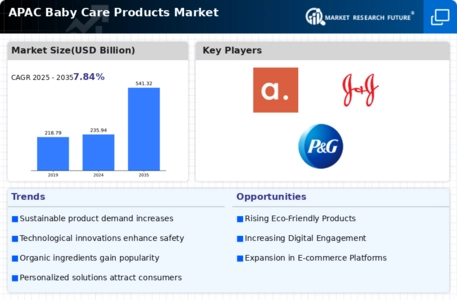Market Analysis
In-depth Analysis of APAC Baby Care Products Market Industry Landscape
The Asia-Pacific (APAC) baby care products market is characterized by dynamic trends and factors that shape its landscape. As one of the most populous and diverse regions globally, the market dynamics of baby care products in APAC are influenced by a combination of cultural, economic, and demographic factors.
Demographically, the region's large population and a growing middle class contribute significantly to the demand for baby care products. Rising income levels and increased awareness of hygiene and child well-being have fueled the demand for a wide range of baby care items, including diapers, wipes, skincare products, and infant nutrition. With parents becoming more discerning about the quality and safety of products, there is a growing preference for premium and organic baby care options.
Cultural factors also play a pivotal role in shaping the APAC baby care products market. Cultural traditions and preferences impact the choice of products, with different countries in the region having unique practices related to baby care. For example, traditional remedies and natural ingredients are often favored in countries like India and China, influencing the formulation and marketing strategies of baby care brands.
Economic development in the APAC region has led to increased urbanization and changes in lifestyle patterns. As more families move to urban areas and adopt modern lifestyles, there is a higher demand for convenient and time-saving baby care solutions. This has led to a surge in the popularity of disposable diapers, baby wipes, and ready-to-feed infant formula, reflecting the market's response to changing consumer needs.
The regulatory environment also contributes to the market dynamics of baby care products in APAC. Stringent regulations regarding product safety and quality vary across countries, influencing the manufacturing processes and marketing strategies of industry players. Adherence to regulatory standards is essential for establishing trust among consumers, and companies often invest in research and development to meet or exceed these standards.
Distribution channels are a key aspect of the APAC baby care products market dynamics. The region's diverse retail landscape includes traditional mom-and-pop stores, hypermarkets, supermarkets, and e-commerce platforms. The rise of online retail has transformed the way consumers access baby care products, providing them with a wide range of options and the convenience of doorstep delivery. E-commerce platforms have become increasingly popular, especially in countries like China and India, where digitalization has rapidly penetrated consumer habits.
The market dynamics are not without challenges. Price sensitivity is a significant factor, particularly in emerging economies, where consumers may prioritize affordability over brand loyalty. Companies need to balance offering high-quality products with price competitiveness to capture a broader market share.
Furthermore, the APAC baby care products market faces environmental considerations, with a growing awareness of sustainability. As consumers become more conscious of the ecological impact of disposable diapers and other single-use items, there is an increasing demand for eco-friendly and reusable alternatives. This shift in consumer preferences is encouraging manufacturers to innovate and incorporate sustainable practices into their product offerings.














Leave a Comment